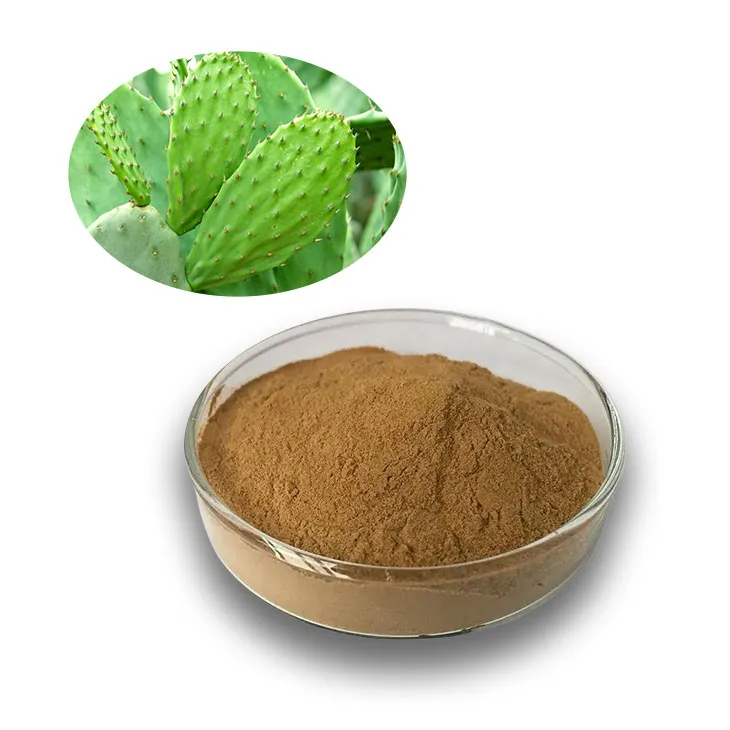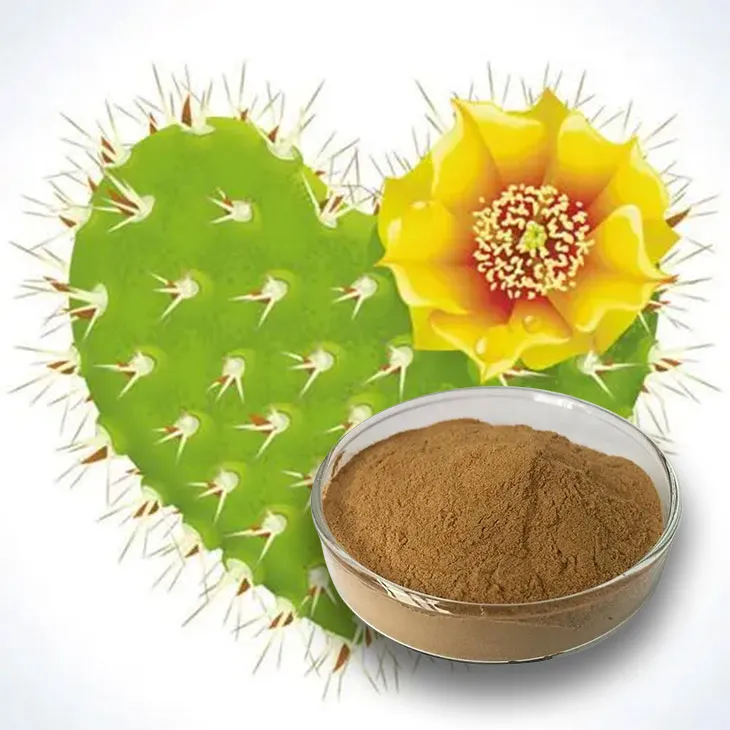- 0086-571-85302990
- sales@greenskybio.com
Cactus Extract: Uses, Advantages, and Manufacturing Processes
2024-11-11

1. Introduction
Cacti are a diverse group of plants that are well - adapted to arid and semi - arid environments. Cactus Extract has recently gained significant attention in various industries due to its numerous potential applications. This extract contains a wide range of bioactive compounds that can be harnessed for different purposes. From nutraceuticals to agriculture, Cactus Extract offers unique properties that make it a valuable ingredient.

2. Nutraceutical Applications
2.1 Nutrient Content
Cactus Extract is rich in several essential nutrients. It contains vitamins such as vitamin C, which is an important antioxidant. Vitamin C helps in protecting the body's cells from damage caused by free radicals. Additionally, cactus extract may also contain minerals like potassium and calcium. Potassium is essential for maintaining proper heart function and regulating blood pressure. Calcium, on the other hand, is crucial for strong bones and teeth.2.2 Antioxidant Properties
One of the most significant advantages of cactus extract in the nutraceutical area is its antioxidant activity. The presence of antioxidants helps in combating oxidative stress in the body. Oxidative stress is associated with various chronic diseases, including heart disease, cancer, and neurodegenerative disorders. Cactus extract contains phenolic compounds, flavonoids, and betalains, which are all known for their antioxidant capabilities. These compounds scavenge free radicals and prevent them from causing damage to cells and tissues.2.3 Potential Health Benefits
- Immune System Boost: The antioxidant and nutrient content in cactus extract may contribute to a stronger immune system. A healthy immune system is better able to fight off infections and diseases. - Digestive Health: Cactus extract has been studied for its potential role in improving digestive health. It may help in reducing inflammation in the digestive tract and promoting the growth of beneficial gut bacteria. - Diabetes Management: Some research suggests that cactus extract may have a role in managing blood sugar levels in diabetes. It may help in improving insulin sensitivity and reducing blood glucose levels.
3. Agricultural Applications
3.1 Plant Growth Promotion
In the agricultural sector, cactus extract can be used to promote plant growth in certain situations. The bioactive compounds present in the extract may stimulate root development in plants. For example, it can enhance the production of root hairs, which are important for nutrient and water absorption. This can lead to healthier and more vigorous plants.3.2 Stress Resistance
Plants are often exposed to various environmental stresses such as drought, salinity, and extreme temperatures. Cactus extract may help plants in developing resistance to these stresses. Since cacti are adapted to harsh arid environments, their extract may contain compounds that can confer similar stress - tolerance mechanisms to other plants. For instance, it may help in regulating the water balance in plants during drought conditions or reducing the damage caused by high salinity in the soil.3.3 Pest and Disease Management
There is some evidence to suggest that cactus extract may have properties that can help in managing pests and diseases in plants. The bioactive compounds in the extract may act as natural repellents against certain pests. Additionally, they may also boost the plant's own defense mechanisms against diseases, such as by enhancing the production of phytoalexins, which are natural antimicrobial compounds produced by plants.
4. Advantages of Cactus Extract
4.1 Environmentally Friendly
Cactus is a sustainable plant source. Cacti are well - adapted to arid regions and require minimal water and other resources for growth. Harvesting cactus for extract production does not put a significant strain on the environment compared to some other plant sources. Moreover, the cultivation of cacti can even contribute to soil conservation in arid areas as their roots help in preventing soil erosion.4.2 Unique Biological Activities
The bioactive compounds in cactus extract exhibit unique biological activities that are not commonly found in other plant extracts. As mentioned earlier, the presence of betalains, which are pigments with antioxidant and anti - inflammatory properties, is one such unique feature. These unique biological activities make cactus extract a valuable ingredient for various applications.4.3 Versatility
Cactus extract can be used in multiple industries, as demonstrated by its applications in nutraceuticals and agriculture. It can also be used in the cosmetic industry, for example, in skin care products due to its antioxidant and moisturizing properties. This versatility makes it an attractive ingredient for different product formulations.5. Manufacturing Processes
5.1 Selection of Cactus Species
The first step in the manufacturing process of cactus extract is the careful selection of cactus species. Different cactus species may contain different levels and types of bioactive compounds. For example, Opuntia ficus - indica is one of the commonly used cactus species for extract production. This species is known for its high content of certain nutrients and bioactive substances. The selection also takes into account factors such as the availability of the cactus species, its ease of cultivation, and the sustainability of harvesting.5.2 Harvesting
Once the appropriate cactus species has been selected, the next step is harvesting. Harvesting should be done at the right time to ensure maximum bioactive compound content. In general, the younger parts of the cactus may contain higher levels of certain beneficial compounds. However, proper harvesting techniques must be employed to avoid damage to the cactus plants and ensure their continued growth and productivity.5.3 Extraction
- Solvent Extraction: One of the common methods for extracting bioactive compounds from cactus is solvent extraction. Organic solvents such as ethanol or methanol can be used. The cactus material is soaked in the solvent, and the bioactive compounds dissolve into the solvent. After a certain period of time, the solvent is separated from the solid residue, and the resulting solution contains the cactus extract. - Supercritical Fluid Extraction: Supercritical fluid extraction is another method that has some advantages. In this method, a supercritical fluid, usually carbon dioxide, is used as the extraction medium. Supercritical carbon dioxide has properties similar to both a gas and a liquid, which allows for efficient extraction of bioactive compounds while being relatively environmentally friendly.5.4 Purification
After extraction, the cactus extract may contain impurities. Purification steps are necessary to isolate the desired bioactive compounds. Techniques such as chromatography can be used for purification. Chromatography separates the different components of the extract based on their chemical properties, allowing for the isolation of the specific bioactive compounds of interest.5.5 Quality Control
Quality control is an essential part of the manufacturing process. The final cactus extract product must meet certain quality standards. This includes testing for the presence and concentration of the desired bioactive compounds, as well as ensuring that there are no harmful contaminants. Analytical techniques such as high - performance liquid chromatography (HPLC) can be used for accurate quantification and identification of the bioactive compounds in the extract.6. Conclusion
Cactus extract has a wide range of uses and advantages in various sectors. In the nutraceutical area, it offers valuable nutrients and antioxidant properties with potential health benefits. In agriculture, it can promote plant growth, enhance stress resistance, and contribute to pest and disease management. The manufacturing process, from cactus species selection to purification and quality control, ensures that a high - quality extract is produced. With its environmentally friendly nature and unique biological activities, cactus extract is likely to continue to gain importance in the future, finding new applications in different industries.
FAQ:
What are the main uses of cactus extract?
Cactus extract has various uses. In the nutraceutical area, it serves as a source of nutrients and antioxidants. In the agricultural sector, it can sometimes promote plant growth.
What are the advantages of cactus extract?
The advantages of cactus extract are numerous. It is environmentally friendly and has unique biological activities. It also provides beneficial substances like nutrients and antioxidants in the nutraceutical field.
How is cactus extract manufactured?
The manufacturing process of cactus extract begins with carefully choosing specific cactus species. Then, purification steps are carried out during the extraction process to isolate the desired compounds.
Are there any specific cactus species better for extraction?
There may be certain cactus species that are more suitable for extraction depending on the desired compounds. However, specific information about which species are better often depends on the intended use of the extract and further research in this area is still ongoing.
Can cactus extract be used in other industries?
While it is mainly known for its uses in the nutraceutical and agricultural industries, there may be potential for cactus extract to be used in other industries as well. For example, in the cosmetic industry, its antioxidant properties might be beneficial. But more research and development are needed to fully explore these possibilities.
Related literature
- Cactus Extracts: A Comprehensive Review of Their Phytochemistry and Pharmacological Properties"
- "The Role of Cactus Extract in Sustainable Agriculture"
- "Cactus Extract: New Insights into Nutraceutical Applications"
- ▶ Hesperidin
- ▶ citrus bioflavonoids
- ▶ plant extract
- ▶ lycopene
- ▶ Diosmin
- ▶ Grape seed extract
- ▶ Sea buckthorn Juice Powder
- ▶ Beetroot powder
- ▶ Hops Extract
- ▶ Artichoke Extract
- ▶ Reishi mushroom extract
- ▶ Astaxanthin
- ▶ Green Tea Extract
- ▶ Curcumin Extract
- ▶ Horse Chestnut Extract
- ▶ Other Problems
- ▶ Boswellia Serrata Extract
- ▶ Resveratrol Extract
- ▶ Marigold Extract
- ▶ Grape Leaf Extract
- ▶ blog3
-
Cranberry Plants and Skin - care Products.
2024-11-11
-
Grape Leaf Extract
2024-11-11
-
Honeysuckle Pollen
2024-11-11
-
Reishi mushroom extract
2024-11-11
-
White mustard seed extract
2024-11-11
-
Licorice Root Extract Powder
2024-11-11
-
Mango flavored powder
2024-11-11
-
Agaricus Blazei Extract
2024-11-11
-
Feverfew Extract
2024-11-11
-
Lemon Juice Powder
2024-11-11
-
Yellow Pine Extract
2024-11-11





















